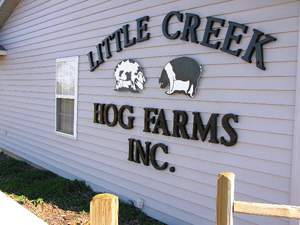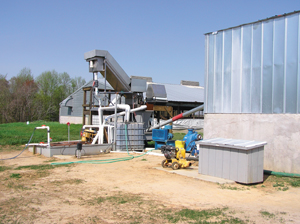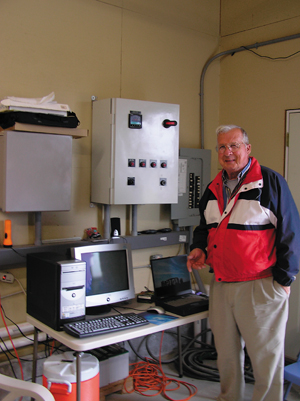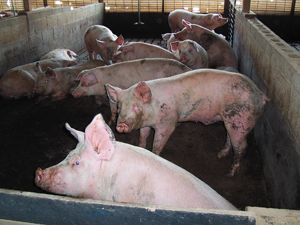
A new—and economically practical—manure treatment system developed for North Carolina hog farmers is looking very positive.
A new—and economically practical—manure treatment system developed for North Carolina hog farmers is looking very positive.
 |
In the late 1990s, the forecast was not terribly good for the Tar Heel State. North Carolina was facing some serious pollution problems: municipal wastes, agricultural run-off, swine manure in lagoons and sprayfields.
Hurricanes and flooding compounded the problem, and certain vocal elements of the population became alarmed. Hog farmers, easily targeted as permit-holders, were soon caught in a crossfire between environmentalists and large meat-based corporations.
In the preceding decade, the state’s swine population had soared and by 1995 was estimated at seven million. The positive economic impact on the state was considerable—processing and packaging plants, transportation systems, farrowing and finishing operations, and the auxiliary industry that centers around the disposal and distribution of the inevitable manure.
 Part of the system in place at North Carolina’s Little Creek Hog farms. It’s estimated the entire system would cost around $150,000 to build, with a monthly electrical cost of $150 and monthly cost of $600 for the TCM and polymer package. Part of the system in place at North Carolina’s Little Creek Hog farms. It’s estimated the entire system would cost around $150,000 to build, with a monthly electrical cost of $150 and monthly cost of $600 for the TCM and polymer package. |
In 1994, the North Carolina legislature mandated the use of the lagoon and sprayfield system, forcing hog farmers into expensive upgrades. But the lagoons themselves presented some new problems. When not properly managed, they are the source of objectionable odor, and application of lagoon liquid is often concentrated near the source. Concerned people demanded an analysis of the effect of the high swine population on water and air quality, and on the general quality of life in North Carolina.
Questions arose. If the lagoon system was environmentally hazardous, what alternative was available to the hog producer? How expensive would the next upgrade be? Would it force North Carolina hog production to go overseas? What would happen to the 49,000 people working in the state’s hog industry? In 1999, the state decreed a moratorium on hog lagoons. There was a predictable rush for quick solutions.
In July 2000, the North Carolina Attorney General and Smithfield Foods, Inc, and its subsidiary companies, agreed to a legally binding pledge to develop and implement new technology that would protect both the environment and the economy. Under the terms of this Smithfield Agreement, the companies would be required to pay $15 million for the development of new technologies. Within a year, Premium Standard Farms joined with Smithfield and contributed more research money. Experts at North Carolina State University would be responsible for identifying, developing and testing environmentally superior technologies.
Once these new technologies were identified, the companies would convert their facilities and phase out the current lagoons and sprayfield systems within three years.
Smithfield would provide the technical and financial assistance for their contract farmers to convert to the new technology. And, of course, Smithfield and its subsidiary companies would play a leadership role in establishing a permanent program to protect water quality in eastern North Carolina, where many of the hog producers were concentrated.
The smaller independent swine producers were skeptical and didn’t feel their interests were being represented. Was any financial aid available to them? They wanted their voices heard. A group of 160 of these independent farmers formed an alliance called Frontline Farmers. Under the leadership of their president, Chuck Stokes, they presented their own willingness to work with the Attorney General to convert from the lagoons to new technology evaluated through North Carolina State University. Frontline signed an agreement to have its members work with scientists and the Attorney General’s office to install experimental technology on farms and share financial information to help analysts determine whether new waste disposal systems are economically feasible.
In 2002, Frontline Farmers partnered with Sustainable North Carolina (formerly called Save Our State), an organization concerned with the mounting problems from hog waste and interested in the development of environmentally sound waste treatment systems. The partnership began constructing and testing a new hog waste technology that was practical, effective and affordable under a $340,000 construction and testing grant from the Environmental Enhancement Fund, administered by the North Carolina Attorney General.
The target technology was designed, developed and patented by Don Lloyd of Environmental Technologies, LLC. Chuck Stokes offered one of his finishing operation sites for the testing. Stokes, a fifth generation North Carolina farmer, finishes about 100,000 head of hogs a year for Hatfield Meats. The manure is used for his soybeans, corn, wheat, fescue, and pastureland for about 400 Angus-Hereford beef cattle. In 1987 Stokes and his wife Kim incorporated Little Creek Hog Farms near Ayden, about 10 miles south of Greenville. The Red Hill Farm, home to some 3,600 “grow-out” hogs in three separate barns, was chosen for a trial run with Don Lloyd’s waste system.
Katherine Ansardi, president of Sustainable North Carolina, and a member of the Smithfield Advisory panel, provides the following simplified explanation of how the technology works:
- Hog waste is flushed out of barns with copious amounts of water, as is standard practice in the industry. Normally that waste would go directly into a lagoon. However, in this case, the waste enters a collection tank.
- In the tank, the liquids and solids separate.
- Ideally, the solids will be converted to Class A biosolids or energy, but the final outcome of the solids has not been decided.
- A polymer floculant and sanitizing solution are injected into the liquid, which then enters a settling tank.
- The polymer settles out the small solids still remaining in the liquid. Some settle at the bottom while others float at the top of the tank. The middle contains clear liquid, and the sanitizer helps kill any remaining pathogens in the liquid.
- The settled and floating solids enter a leach field (similar to a home septic system).
- The clear water is divided into two streams.
- The first stream is reused to flush out hog barns.
- The second stream undergoes additional wastewater treatment with filters and aeration.
It can then be diluted with fresh water and used as drinking water for the hogs.
 System developer Don Lloyd. A computer runs the system—the farmer pushes a button and the system System developer Don Lloyd. A computer runs the system—the farmer pushes a button and the system runs itself. |
Don Lloyd elaborates enthusiastically on some of the steps of his patented system. The polymer, approved by the FDA and USDA, is capable of grabbing hold of bits of solid waste from ten to 200 microns in size. The sanitizer, referred to as a TCM, was used during the Korean War to purify drinking water for military ground troops. The whole system is run by a computer programmed according to Lloyd’s specifications. The farmer pushes a button and the system runs itself. Maintenance is uncomplicated: The farmer spends about one hour a week cleaning the separator. No waste touches the ground. The solids are currently used as fertilizer on the Stokes farms, but Lloyd envisions a process that will transform solids into a powder, an easily transportable Class A organic fertilizer.
Stokes has discontinued use of spray reel equipment to spread the fertilizer. He now uses a system that incorporates the waste into the ground through the use of a soil aeration machine and drag hose reel. He likes the new system, which produces less odor and greatly reduces the chance for unwanted run-off.
If the solids can be efficiently converted to an easily stored powder form of fertilizer, Stokes will have more flexibility with application. He likes the idea of using fertilizer at the precise window of time when a specific crop demands it.
It was a major achievement to convert wastewater to potable water for the pigs. Stokes points out that a senser in the tank alerts the farmer if the dissolved solids are above an acceptable level. If so, fresh water is added.
His pigs have been drinking this water for six weeks with no complications. Better yet, asserts Stokes, consumption of water in his operation has decreased by 50 to 60 percent. This is good news for communities that share water from an already overtaxed aquifer.
According to Ansardi, preliminary results indicate that, subject to the same standards required of technologies under the Smithfield Agreement, this target method is exceeding expectations.
The “cool season” testing is finished, and the “warm season” testing is scheduled in May. At a publicity event in May, Lloyd and Stokes are prepared to drink water from the system, thus spotlighting how successfully the EEG (Environmental Enhancement Grant) can work.
Bottom-line cost estimates are encouraging, too. Lloyd estimates that the entire system would cost around $150,000 to construct, with a monthly electrical cost of $150 and a monthly cost of $600 for the TCM and polymer package. Currently, the estimated expense for a lagoon and sprayfield system is $80 per 1,000 pounds of steady state, live weight. Lloyd believes the new system would cost considerably less. Environmental Technologies, LLC, is currently seeking financial backing to make the system available on a much larger scale.
Stokes is pleased both with the new waste system and with the clout the smaller farmers gained when they joined Frontline Farmers with Sustainable North Carolina. The process worked. A farmer sits on the state advisory panel. A grant was obtained and evaluations administered by NCSU. Stokes has piloted a successful new program at Little Creek Hog Farms.
 Hogs at the Stokes farm: it was a major achievement for the system to convert wastewater to potable water for the hogs. Hogs at the Stokes farm: it was a major achievement for the system to convert wastewater to potable water for the hogs. |
“Hog farmers allow people to eat cheaply,” says Stokes. “But if we tamper too much with our slim profit margin, we’re inviting problems. Where is the farmer’s responsibility? We can be independent, stubborn people, or we wouldn’t be farming in the first place. We’ve got to learn to work together.”
And work together they have. According to the Sustainable North Carolina’s website, “Successful completion of the project will give North Carolina’s small growers a highly affordable alternative to replace their hog lagoons with a waste treatment system that will protect the state’s rivers, water tables, rural neighborhoods and air quality, as well as a way to recycle and conserve millions of gallons of much-needed water.”
Technologies such as this offer the promise of a healthy environment and a healthy farm economy for North Carolina’s future.